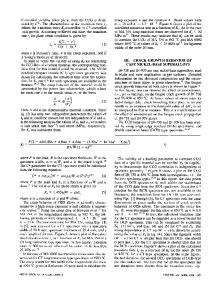Environmentally assisted fatigue crack propagation in steel
- PDF / 1,728,938 Bytes
- 8 Pages / 612 x 792 pts (letter) Page_size
- 87 Downloads / 386 Views
HYDROGEN
has been known for some time t o adversely affect the mechanical properties of steel.1 The embrittling hydrogen may be internal (the r e s u l t of t h e r m a l or electrolytic charging) or ext e r n a l (deformation in an environment containing hydrogen g a s ) . It has been shown, however, that the presence of relatively s m a l l amounts of oxygen in the gaseous hydrogen environment would prevent the ductility loss normally associated w i t h deformation in a hydrogen environment.2 It has also been shown that oxygen additions were able t o stop subcritical c r a c k growth in s t e e l under sustained load in a h y drogen environment.3 The protection against g a s e ous hydrogen embrittlement afforded by oxygen additions has also been shown t o o c c u r for nickel,4 nickel alloys,%8 and titanium? The usual model for this phenomenon involves the preferential adsorption of oxygen at the m e t a l surface which prevents the adsorption and dissociation of hydrogen. This model has been verified for adsorption on nickel by low e n e r g y electron diffraction (LEED) showing that when oxygen was added t o a hydrogen environment the oxygen would displace the adsorbed hydrogen on the nickel surface resulting in an adsorbed layer of oxygen.8 S e v e r a l investigators have shown that oxygen was not unique in preventing environmental hydrogen embrittlement, but that other g a s e s such as w a t e r vapor,9 carbon disulfide, and sulfur dioxide1° were also able to inhibit hydrogen accelerated subcritical cracking. With only a few exceptions these investigations were very qualitative, typically reporting only whether each gaseous adaition to the hydrogen environment was able t o prevent subcritical cracking or not. Hydrogen assisted fatigue not propagation preJ. D. FRANDSEN, is Senior Staff Associate, ScienceCenter, RockwellInternational, Thousand Oaks, CA 91360. H. L. MARCUS, formerly with Science Center,RockwellInternational, Thousand Oaks, CA, is now Professor of Mechanical Engineeringand Materials Science Engineering, University of Texas at Austin, TX. Manuscript submitted June 13, 1976. METALLURGICAL TRANSACTIONS A
sents a useful test condition for examining the interaction in a multicomponent environment. The purely mechanical component of fatigue c r a c k propagation constantly produces new fracture surface during the cyclic loading and competitive adsorption between the gaseous species is then continuous. The continuous nature of this test also m a k e s it possible t o quantify the o v e r a l l interaction by the measurement of the cyclic c r a c k growth rate (a quantity which also has practical significance). A very useful experimental tool t o aid in interpreting environmental interactions with fracture processes has been electron fractography and this is particularly true when t h e r e a r e s e v e r a l possible different interactions. In this investigation, the fatigue c r a c k propagation rate was m e a s u r e d in six different g a s e s singly and in combination with hydrogen to determin
Data Loading...











